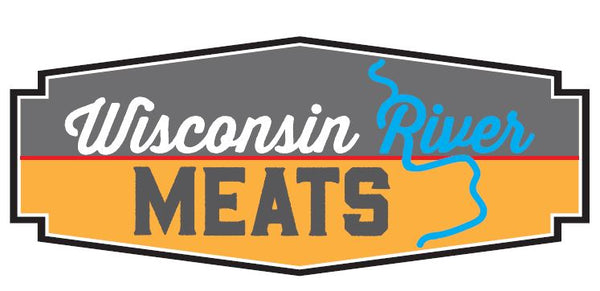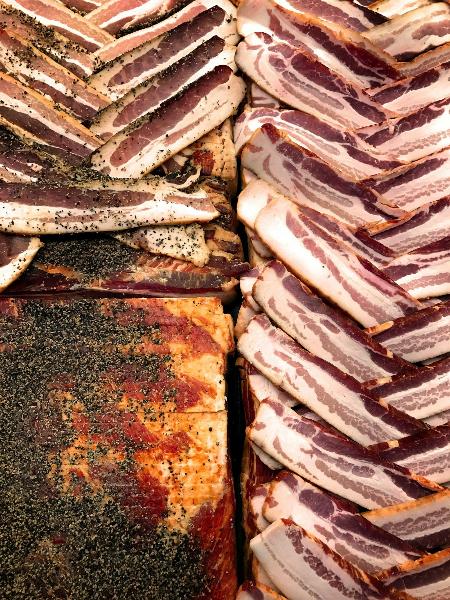The Ultimate Guide to Venison: What It Is and How to Cook Venison Steaks, Roasts, and Tenderloin Like a Pro
Share
For generations, venison has been one of the most prized wild meats on the table, especially in Wisconsin. Whether it’s a holiday feast, a hunting camp dinner, or a weeknight meal, venison delivers incredible flavor, excellent nutrition, and a connection to the land that few other meats can match.
If you’re new to cooking deer meat — or simply want to improve your skills — you might be wondering:
-
What is venison?
-
Is venison healthy?
-
How do you cook venison properly?
-
What’s the best way to cook venison steak?
-
How do you cook venison tenderloin?
At Wisconsin River Meats, where we’ve proudly helped hunters and families process wild game for decades, we know venison deserves respect, skill, and the right cooking methods. Here’s your complete guide to understanding, preparing, and enjoying venison the way it was meant to be savored.
What Is Venison?
Simply put, venison refers to deer meat. In North America, venison usually means meat from white-tailed deer or mule deer, but around the world it can include elk, moose, red deer, reindeer, or fallow deer.
Venison is a deeply traditional protein, dating back to the first humans who hunted wild game. Even today, it is one of the most sustainable and wholesome meats available, thanks to the natural diet of wild or free-ranging deer.
Venison stands out because it is:
-
Exceptionally lean compared to beef or pork
-
High in protein
-
Rich in iron and B vitamins
-
Naturally free from antibiotics and growth hormones
In addition, venison has a subtly earthy, slightly sweet, mild flavor that takes beautifully to herbs, berries, and wine-based sauces. When handled and prepared correctly, it is never “gamey” but instead deeply satisfying and refined.

Is Venison Healthy?
Absolutely. Venison is one of the healthiest red meats you can serve. Here’s why:
-
It’s lower in saturated fat than beef or lamb
-
Naturally higher in iron, supporting healthy blood and energy
-
A great source of B vitamins, including B6 and B12
-
Contains zinc and selenium for immune support
-
Lean cuts can be part of low-fat, high-protein meal plans
Like any red meat, venison should be balanced with vegetables, fruits, and whole grains in a diverse diet. But if you want clean, naturally raised protein with real flavor, venison is hard to beat.
How to Cook Venison: The Basics
One of the most important things to remember about cooking venison is its leanness. Deer live active lives and have little fat compared to farm-raised beef. That means overcooking venison can quickly turn it dry and tough.
General rules for cooking venison:
-
Aim for rare to medium-rare (125–135°F) for tender cuts
-
Rest your meat after cooking to retain juices
-
For tougher cuts, use moist, slow braising
-
Add a touch of fat (bacon grease, butter, or oil) if desired
-
Marinate lean cuts to improve moisture
If you want to avoid a dry result, do not treat venison like a well-marbled beef steak. Instead, respect its lean nature and give it careful, gentle heat.
Best Ways to Cook Venison
Venison is wonderfully versatile. Here’s how to match the cooking method to the cut:
-
Backstrap/loin (steaks): hot and fast grilling, pan-searing
-
Tenderloin: pan-seared or lightly roasted, rare to medium-rare
-
Shoulder and shank: low and slow braising, stews
-
Roasts (round, sirloin tip): slow roasting or braising
-
Ground venison: burgers, chili, tacos, meatballs
The general pattern is simple: tender cuts get quick, high heat, while tougher cuts get low, slow, moist cooking to break down connective tissue.
How to Cook Venison Steak
Venison steaks, typically from the backstrap or top round, are lean and naturally tender. These are best cooked quickly at a high temperature. Here’s a classic approach:
-
Pat the steaks dry to help them sear well.
-
Season generously with kosher salt, fresh cracked pepper, and fresh herbs like rosemary or thyme.
-
Heat a cast-iron skillet over medium-high heat with a bit of high-heat oil.
-
Place the venison steaks in the pan, cooking about 2–3 minutes per side, depending on thickness.
-
If the steak is thick, finish in a 375°F oven for 3–5 minutes until an internal temperature of 125–130°F is reached.
-
Rest for 5 minutes before slicing.
You can also grill venison steak over medium-high heat, using the same timing. Because venison steak is lean, you might brush it with a little oil or melted butter to prevent sticking and improve the crust.
For extra flavor, finish with a spoonful of garlic-herb butter, or a quick pan sauce made by deglazing with red wine and adding a splash of broth.

How to Cook Venison Tenderloin
Venison tenderloin is the prized “filet mignon” of deer, with an exceptionally mild, delicate flavor and melt-in-your-mouth texture. Because it’s so lean, cooking venison tenderloin takes a gentle touch:
-
Trim off any silverskin for the cleanest bite.
-
Season lightly with salt, pepper, and a drizzle of olive oil.
-
Heat a skillet over medium-high heat with a splash of oil.
-
Sear the tenderloin for about 2 minutes per side, until browned.
-
Transfer to a 375°F oven for about 5 minutes, until the center reaches 125–130°F.
-
Rest for 5 minutes before slicing thinly.
Venison tenderloin needs no heavy sauces. A sprinkle of fresh herbs and a squeeze of lemon can be enough to highlight its mild richness.
How to Cook Venison Roasts and Other Cuts
Larger venison roasts, like the round or shoulder, are perfect for slow braising. This method breaks down the tougher muscle fibers and creates a fork-tender result.
Simple braised venison roast:
-
Brown the roast in a Dutch oven
-
Add onions, garlic, carrots, celery, and fresh herbs
-
Pour in beef broth, red wine, or a mixture of both
-
Cover and braise in a 300°F oven for 3–4 hours, until tender
The broth becomes a flavorful gravy, and the meat will shred beautifully for sandwiches, tacos, or a hearty supper.
Venison Cooking Tips
Here are the golden rules for how to cook deer meat with confidence:
-
Never overcook lean cuts
-
Use a thermometer to monitor doneness
-
Rest meat before slicing to hold in juices
-
Add fat through a marinade or cooking method if you want a juicier bite
-
Try game-friendly flavors like juniper, rosemary, black pepper, and red wine
If you’re grinding venison for burgers, add about 20% pork fat for a juicier patty. That blend delivers great sear and helps bind the ground meat together.
Flavor Pairings for Venison
Because venison is mild and slightly earthy, it pairs beautifully with bold, aromatic ingredients. Some of the best flavors to match venison include:
-
Rosemary
-
Garlic
-
Thyme
-
Juniper berries
-
Sage
-
Red wine reductions
-
Cranberries or cherry sauce
-
Wild mushrooms
-
Black pepper
These flavors accent venison without overwhelming it. In Wisconsin, many families serve venison with wild rice, caramelized onions, and root vegetables for a true Northwoods-style meal.

Frequently Asked Questions
What temperature should venison be cooked to?
For steaks and tenderloin, aim for 125–130°F. For roasts or braises, cook until tender, usually around 190–200°F internal for pulled or shredded venison.
Is venison dry?
It can be if overcooked. Venison is extremely lean, so watch your temperatures carefully.
Do you need to soak venison before cooking?
If the meat was properly aged and handled, soaking is not necessary. Some hunters brine venison to add moisture or mild seasoning, but it’s not required.
What is the best fat to add to venison?
Bacon grease, pork fat, or even beef tallow are excellent options if you want to blend in fat for venison burgers or sausage.
How long does venison last in the freezer?
Properly wrapped venison will keep for up to 12 months at 0°F.
Why Wisconsin River Meats Is Your Venison Partner
At Wisconsin River Meats, we respect the tradition of Wisconsin hunting culture and help hunters turn their harvest into premium sausage, jerky, and summer sausage using authentic hardwood smoke and classic recipes. We believe the hard work you put into the hunt deserves processing with the same care and skill.
We use small-batch, time-honored methods to bring out the best flavor and protect your investment. Whether you want classic summer sausage, fresh bratwurst, or smoked venison snack sticks, our team is ready to help.
Learn more about our deer processing services here if you’d like to make the most of your next harvest.
How to Serve Venison
Venison is flexible enough for everyday dinners or elegant celebrations. Here are a few ways to enjoy it:
-
Sliced venison tenderloin with wild mushroom sauce
-
Grilled venison steak with garlic-herb butter
-
Slow-braised venison roast with red wine gravy
-
Venison chili with beans, tomatoes, and smoky chipotle
-
Venison backstrap grilled with rosemary and served over mashed potatoes
-
Venison summer sausage sliced on a cheeseboard
Because venison is naturally lean, pairing it with hearty grains like barley, farro, or wild rice makes a complete, satisfying meal. Add a simple salad or roasted vegetables for color and crunch.
Final Thoughts
Venison is more than just a wild game meat — it’s a Wisconsin tradition. With its clean, mild flavor, exceptional nutrition, and connection to the land, it deserves a place on any table.
Remember these key points:
-
Venison is best cooked gently, rare to medium-rare
-
Add fat or marinade to keep it moist
-
Pair with aromatic herbs and sauces to enhance the flavor
-
Rest meat before slicing
-
Respect the lean, natural character of deer meat
At Wisconsin River Meats, we believe venison celebrates the best of local hunting, honest craftsmanship, and family meals that bring people together. Whether you’re grilling venison steak for the first time or experimenting with venison tenderloin for a holiday dinner, these tips will help you do it right.
If you’d like to learn more about seasoning, sausage making, or venison recipes, let us know — we’re always here to help you enjoy your harvest to the fullest.
Check out our venison processing services and supplies here and bring home the flavor of Wisconsin tradition.

